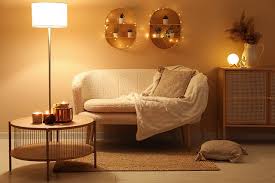How Lighting Can Boost Your Home’s Appeal to Buyers?

Lighting represents one of the most underestimated yet powerful tools for enhancing property appeal during sales. While sellers often focus on major renovations or expensive staging, strategic lighting improvements can transform how buyers perceive spaces, creating emotional connections that drive purchase decisions and potentially increase sale prices.  
The impact of lighting extends far beyond mere illumination, affecting how rooms feel in terms of size, warmth, and functionality. Professional estate agents in Weybridge and across Surrey consistently observe that well-lit properties generate more positive buyer responses and often achieve quicker sales than similar homes with poor lighting strategies.  
Understanding how lighting influences buyer psychology and implementing targeted improvements can provide exceptional returns on relatively modest investments. The key lies in recognising that buyers form emotional impressions within minutes of entering properties, and lighting plays a crucial role in shaping these critical first responses.  
The Psychology of Lighting in Property Sales:  
Lighting profoundly affects human psychology and behaviour, influencing how spaces feel and how people respond emotionally to environments. These psychological effects become particularly important during property viewings, where buyers make rapid assessments based on immediate impressions. 
Natural light remains the most desirable lighting source for most buyers, creating feelings of spaciousness, freshness, and connection to the outdoors. Properties that maximise natural light through clean windows, minimal window treatments, and strategic mirror placement consistently appeal more to buyers than those that feel dark or enclosed.  
Warm lighting creates welcoming, comfortable atmospheres that help buyers envision themselves living in properties. Cool, harsh lighting can make spaces feel institutional or unwelcoming, whilst poor lighting levels make rooms appear smaller and less appealing than their actual dimensions.  
Layered lighting approaches that combine ambient, task, and accent lighting create sophisticated environments that suggest quality and attention to detail. These lighting strategies help buyers perceive properties as well-designed and move-in ready rather than requiring immediate improvement.  
Consistency in lighting quality throughout properties prevents jarring transitions that can break the positive flow of viewings. Ensuring similar light levels and colour temperatures across different rooms creates cohesive experiences that enhance overall property impressions.  
Maximising Natural Light Impact:  
Natural light enhancement often provides the highest return on investment for sellers looking to improve property appeal. Simple strategies can dramatically increase the amount and quality of natural light without expensive modifications.  
Window cleaning represents the most cost-effective lighting improvement available. Dirty windows can reduce natural light transmission by 20-30%, making rooms appear significantly darker than necessary. Professional cleaning inside and outside, including frames and sills, creates immediate improvement in light quality.  
Window treatments should balance privacy needs with light maximisation. Heavy curtains or dark blinds that block significant light make rooms feel smaller and less welcoming. Light-coloured, translucent treatments or blinds that can be fully opened allow maximum light whilst maintaining privacy options.  
Mirror placement strategically positioned to reflect natural light can effectively double the apparent light in rooms. Large mirrors opposite windows or positioned to catch light from adjacent rooms create brighter, more spacious feelings without structural modifications.  
Decluttering windowsills and nearby areas prevents obstruction of natural light sources. Plants, ornaments, or furniture positioned near windows can create shadows and reduce light transmission, whilst clear window areas maximise available natural illumination.  
Strategic Artificial Lighting Improvements:  
Artificial lighting provides opportunities to enhance property appeal during evening viewings and in areas where natural light is limited. The key lies in creating lighting schemes that complement and extend natural light rather than competing with it.  
Ceiling lighting should provide adequate general illumination without creating harsh shadows or glare. Modern LED ceiling lights offer excellent energy efficiency and light quality, whilst outdated fluorescent or poor-quality fittings can make properties feel dated and unwelcoming.  
Table and floor lamps create warm, inviting atmospheres that help buyers envision comfortable living in properties. Strategically placed lamps in living areas, bedrooms, and hallways add warmth and sophistication that overhead lighting alone cannot achieve.  
Under-cabinet lighting in kitchens provides both practical task lighting and creates an attractive ambiance that showcases kitchen features. LED strip lighting is relatively inexpensive to install and immediately improves how kitchens appear during viewings.  
Feature lighting such as wall sconces, picture lights, or architectural lighting can highlight the property’s best features whilst creating sophisticated ambiance. These lighting elements suggest attention to detail and quality that appeals to discerning buyers.  
Room-Specific Lighting Strategies:  
Different rooms require tailored lighting approaches that enhance their specific functions whilst contributing to overall property appeal. Understanding these requirements helps sellers prioritise lighting improvements effectively.  
Living areas benefit from layered lighting that combines general illumination with accent lighting that creates comfortable, welcoming atmospheres. Table lamps, floor lamps, and ceiling lighting working together create flexibility that appeals to buyers imagining different usage scenarios.  
Kitchen lighting requires both functional task lighting and attractive ambient lighting that showcases the space effectively. Under-cabinet lighting, pendant lights over islands or breakfast bars, and general ceiling lighting combine to create appealing, functional environments.  
Bedroom lighting should create relaxing, comfortable atmospheres whilst providing adequate illumination for viewing furniture and features. Bedside lamps, ceiling lighting, and natural light optimisation combine to create appealing sleeping environments.  
Bathroom lighting requires a careful balance between functional illumination for grooming activities and attractive ambiance for relaxation. Good lighting around mirrors combined with general room lighting creates appealing, spa-like environments that buyers value.  
Exterior and Entrance Lighting:  
First impressions begin before buyers enter properties, making exterior lighting crucial for creating positive initial responses. Well-designed exterior lighting suggests security, quality, and attention to detail that influences buyer perceptions.  
Entrance lighting should clearly illuminate front doors whilst creating welcoming atmospheres that encourage positive expectations about property interiors. Attractive porch lights, pathway lighting, or landscape lighting contribute to impressive first impressions.  
Security lighting demonstrates practical benefits whilst suggesting that properties are well-maintained and secure. Motion-sensor lights or timer-controlled lighting systems appeal to buyers concerned about safety and energy efficiency.  
Garden and landscape lighting can highlight outdoor features whilst extending living spaces visually into garden areas. Strategic outdoor lighting makes properties appear larger and more sophisticated during evening viewings.  
Cost-Effective Lighting Improvements:  
Lighting improvements offer exceptional value compared to major renovations, often providing a significant impact on buyer appeal for relatively modest investments. Understanding which improvements offer the best returns helps sellers allocate budgets effectively.  
LED bulb upgrades throughout properties provide immediate improvements in light quality whilst demonstrating energy efficiency that buyers increasingly value. Modern LED bulbs offer superior light quality compared to older technologies whilst reducing ongoing energy costs.  
Fixture updates in key areas can modernise properties without extensive electrical work. Replacing dated light fixtures in hallways, kitchens, or bathrooms with contemporary alternatives creates immediate improvement in property appeal.  
Professional electrical consultation can identify opportunities for lighting improvements that significantly enhance property value. Qualified electricians often suggest modifications that sellers might not consider but provide substantial returns on investment.  
Smart lighting systems demonstrate technological sophistication whilst providing practical benefits that appeal to modern buyers. Smart switches, dimmers, or automated systems suggest forward-thinking design that differentiates properties from competition.  
Seasonal and Viewing Considerations:  
Lighting requirements vary seasonally and depending on viewing times, making flexibility important for maintaining optimal property presentation throughout marketing periods.  
Winter viewings require particular attention to artificial lighting since natural light is limited during shorter days. Properties that rely heavily on natural light might struggle during winter months without adequate artificial lighting supplementation.  
Evening viewings present opportunities to showcase sophisticated lighting designs whilst creating intimate, welcoming atmospheres. Properties with effective evening lighting often make stronger emotional impressions than those viewed only during daylight hours.  
Seasonal lighting adjustments can maintain optimal property presentation as conditions change. Understanding how lighting needs vary throughout the year helps sellers maintain consistently appealing property presentation during extended marketing periods.  
Effective lighting strategy requires understanding that illumination affects every aspect of how buyers perceive properties. Strategic lighting improvements create emotional connections whilst highlighting practical benefits, ultimately contributing to faster sales and potentially higher achieved prices. The investment in quality lighting pays dividends through enhanced buyer appeal and improved property positioning in competitive markets. 




